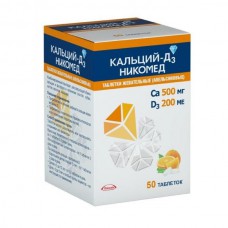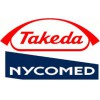Expiration date: 08/2026
Clinico-pharmacological group
(The drug, regulating the exchange of calcium and phosphorus)
release form, composition and packaging
Chewable tablets uncoated, round, lenticular, white color, with aroma of orange, may have small inclusions and uneven edges.
1 tablet contains:
calcium carbonate 1250 mg
equivalent to elemental calcium 500 mg
cholecalciferol (Vit. D3) 5.0 µg (200 IU)
in the form of a concentrate of cholecalciferol 2.0 mg
Pharmacological action:
Combination drug regulating calcium and phosphorus in the body (in bones, teeth, nails, hair, muscles).Decreases resorption (resorption) and increase bone density, offsetting the lack of calcium and vitamin D3 in the body, essential for mineralization of teeth.Calcium is involved in the regulation of nerve conduction, muscle contraction and is a component of the blood coagulation system. Adequate calcium intake is especially important during growth, pregnancy and lactation.Vitamin D3 increases the absorption of calcium in the intestine.The use of calcium and vitamin D3 prevents increase the production of parathyroid hormone, which stimulates increased bone resorption (leaching of calcium from bones).
?????????????????????????????????????? the amount of calcium that is absorbed from the gastrointestinal tract is approximately 30% of the dose.Distribution and metabolism 99% of calcium in the body is concentrated in the hard structure of bones and teeth. The remaining 1% is found in intra - and extracellular fluids. About 50% of the total content of calcium in the blood is in the physiologically active ionized form, from about 10% in complex with citrate, phosphate or other anions, the remaining 40% protein bound, primarily to albumin.Vvedenskii excreted through the bowels, kidneys and sweat glands. Renal excretion depends on glomerular filtration and tubular reabsorption of calcium.???????????????????????????????????????? is readily absorbed from the small intestine (approximately 80% of the dose).Distribution and metabolismrelated and its metabolites circulate in the blood bound to specific globulin. Colecalciferol metabolized in the liver by hydroxylation to 25-hydroxycholecalciferol. Then converted in the kidney to its active form 1.25-hydroxycholecalciferol. 1.25-hydroxycholecalciferol is the metabolite responsible for increasing calcium absorption. Unmodified cholecalciferol stored in the adipose and muscle tissue.Wavegeneration excreted by the kidneys and through the intestines.
Dosage
Tablets can be chewed or sucked on and taken with food.Calcium-D3 Nikolevsky for the prevention of osteoporosis - on 1 tab. 2 times/day in the treatment of osteoporosis - on 1 tab. 2-3 times/day.To fill the shortage of calcium and vitamin D adults and children over 12 years - on 1 tab. 2 times/day, children from 5 to 12 years - 1-2 tablets./day, children from 3 to 5 years - the dosage in accordance with doctor's recommendations.Calcium-D3 Nycomed Fortuntaly for the prevention of osteoporosis - on 1 tab. 2 times/day or 2 tab.1 time/day, kompleksnoi therapy osteoporosis - on 1 tab. 2-3 times/day a day.To fill the shortage of calcium and vitamin D adults and children over 12 years - 2 tab./day, children from 3 to 12 years - on 1 tab./day or as directed by your doctor.
Duration lacenaire application in prevention and complex therapy of osteoporosis, the duration of treatment is determined individually.When applying for the shortfall of calcium and vitamin D3 average duration of treatment at least 4-6 weeks. The number of repeated courses during the year is determined individually.Special group patientopinion with impaired liver dose adjustment is not required.It should not be used in severe renal failure.Elderly patients are assigned the same dose as for adults. Consider the reduction in creatinine clearance.
Overdose:
Symptoms: manifestations of hypercalcemia - anorexia, thirst, polyuria, muscle weakness, nausea, vomiting, constipation, abdominal pain, fatigue, bone pain, mental disorders, nephrocalcinosis, urolithiasis and, in severe cases, cardiac arrhythmia. Long-term use of excessive doses (more than 2,500 mg of calcium) - of kidney damage, calcification of soft tissues.In case of overdose symptoms the patient should stop taking calcium and vitamin D, and thiazide diuretics and cardiac glycosides, and consult a doctor.Treatment: gastric lavage, replacement of fluid loss, the use of "loop" diuretics (e.g., furosemide), corticosteroids, calcitonin, bisphosphonates. It is necessary to control the content of electrolytes in plasma, renal function and diuresis. In severe cases, it is necessary to measure Central venous pressure and ECG monitoring.
Drug interactions:
Hypercalcemia can potentiate the toxic effects of cardiac glycosides while the use of drugs of calcium and vitamin D. the Necessary monitoring of ECG and calcium content in blood serum.Calcium can reduce the absorption of tetracyclines from the gastrointestinal tract. Therefore, tetracycline drugs should be taken at least 2 hours before or 4-6 hours after taking the drug.To prevent decrease absorption of drugs bisphosphonates it is recommended to take at least 1 hour before taking Calcium-D3 Nycomed.Corticosteroids reduce calcium absorption, so the GCS may require increasing the dose of Calcium-D3 Nycomed.With simultaneous use of thiazide diuretics series increases the risk of hypercalcemia, because they increase tubular reabsorption of calcium. With simultaneous use of thiazide diuretics should regularly monitor the content of calcium in the blood serum.Calcium reduces the effectiveness of levothyroxine, reducing its absorption. The period of time between doses of levothyroxine and Calcium-D3 Nycomed shall not be less than 4 h. the absorption of the antibiotics group chinolone decreases in concurrent usage with drugs calcium. Therefore, the antibiotics group chinolone should be taken 2 hours before or 6 hours after taking Calcium-D3 Nycomed.The intake of foods containing oxalates (sorrel, rhubarb, spinach) and phytin (cereals), reduces calcium absorption, so should not take Calcium-D3 Nycomed within 2 h after ingestion of sorrel, rhubarb, spinach, cereals.
Pregnancy and lactation:
Calcium and vitamin D3 use in pregnancy to compensate their deficiency in the body.During pregnancy the daily dose should not exceed 1500 mg calcium and 600 IU of vitamin D3.Hypercalcaemia on a background of a drug overdose during pregnancy can have adverse effects on the developing fetus.The drug is used during lactation.Calcium and vitamin D3 can penetrate into breast milk, therefore it is necessary to consider the intake of calcium and vitamin D from other sources in the mother and child.
Side effects:
The frequency of side effects is considered as follows: very common (>,, 1/10), common (>,, 1/100, <,, 1="" 10="">,, 1/1000, <,, 1="" 100="">,, 1/10 000, <,, 1="" 1000="" 10="" 000="" p="">,
From the metabolic and nutritional: infrequent - hypercalcemia, hypercalciuria.
From the digestive system: rarely - constipation, flatulence, nausea, abdominal pain, diarrhea, dyspepsia.
The skin and subcutaneous tissue: very rare - itching, rash, hives.
Terms and conditions of storage:
The drug should be stored in a tightly closed bottle in a dry, inaccessible for children place at temperature not exceeding 25°C. shelf Life - 3 years. Do not use after expiration date.






